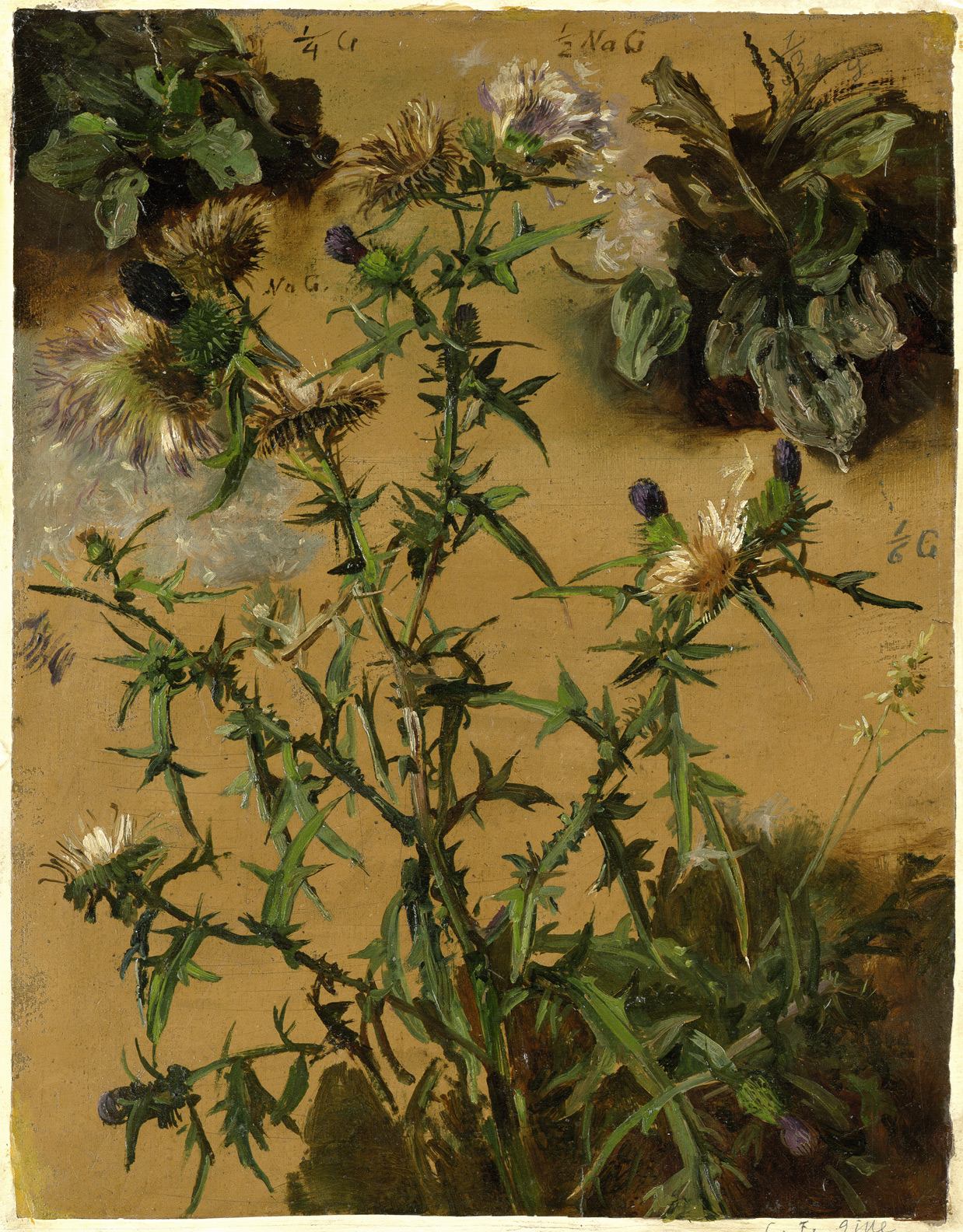Loading the page ...
Christian Friedrich Gille
(1805 Ballenstedt – 1899 Dresden)
Thistles. Oil on paper, mounted on painting board. 36 x 27.8 cm.
Gille’s oil sketches and studies drawn from nature, which amaze modern-day observers with their timeless artistic freshness and spontaneity, were produced in great profusion almost continuously from the late 1820s to about 1870/80. This makes it all the harder to understand why Gille’s artistic output was scarcely appreciated in his lifetime. The artist lived in modest circumstances and was often forced to take on casual jobs to make ends meet.
Born in a little village in the Harz Mountains, Christian Friedrich Gille went to Dresden in 1825 and trained at the Academy there, initially as an engraver. His further artistic development was determined by the years he spent studying under Johann Christian Clausen Dahl (1827–30), who instructed Gille in the principles of landscape painting. Gille’s subsequent career as a freelance painter was mainly characterized by lack of recognition, a few modest successes notwithstanding. In the 1830s financial difficulties caused Gille to turn to lithography and he later worked variously as a reproductive engraver, illustrator, porcelain painter and drawing master. A small pension from the Dresden Academy and the support of private sponsors enabled him to continue his artistic activities to an advanced age (see G. Spitzer, Christian Friedrich Gille 1805–1899, Leipzig 1994).
Though barely noticed by his contemporaries, Gille is now considere to be one of the most important Dresden landscape artists of the Romantic period. It is primarily Gille’s oil studies that have brought him this late recognition, revealing him to be the pioneer of an objective and realistic view of landscape. The subjects of these studies, which were painted en plein air directly from nature, are entirely sober and unpretentious, owing their effect to their immediacy and closeness to nature. Despite this apparent simplicity, Gille’s art is never austere. His deep respect for nature in its manifold and humblest manifestations and his unconventional view of the world about us radiate a highly individual lyricism. Gille’s painting style is correspondingly free-ranging, relaxed and independent of the prevailing taste of his day. The uncompromising realism of his art and its freedom from clichés influenced the development of the young Adolph von Menzel. As in Menzel’s case, Gille’s oil sketches served the systematic exploration of an infinitely complex nature and the perfecting of his own artistic skills, and were not intended as preliminary studies for paintings. In his easel paintings, which rest on a conventional, idealistic concept of landscape, Gille reveals himself as very much a man of his time.
Gille himself doubtless received the key inspiration for his oil studies from nature from his tutor Dahl. But unlike Dahl, who saw this kind of oil study primarily as an aid for paintings to be done in the studio, Gille regarded the spontaneous capture of a landscape in the open air as an artistic form in its own right and one which he pursued for more than half a century with admirable single-mindedness and consistency (see illustration).
The present study of thistles, which in view of its broad picturesque lines probably belongs to the late work and was done in the 1860s, convincingly and memorably illustrates the advantages of his artistic vision. Especially in the late oil studies the artist attained an increasingly uninhibited view of nature and a masterly rendering of changing lighting conditions and fleeting atmospheric phenomena. The silent unassuming power of the subject and the fluid, broad and consummate brushwork lend the portrayal a timeless presence. The thorny stalks of the thistles with their white and violet blooms have been artfully arranged in a manner suggestive of arabesques, while the dense foliage of two meadow plants right at the top forms a compositional counterpoint. The deep, richly modulated green of the stalks and leaves contrasts effectively with the yellowish-brown painting base.
Most of the credit for Gille’s rediscovery goes to the private collector Johann Friedrich Lahmann (1858–1937), who was the first to notice the large fund of oil studies and drawings the artist had left and acquired a considerable part of the oeuvre, some of which he bequeathed to the Staatliche Kunstsammlungen in Dresden and the Kunsthalle in Bremen, the city in which he was born. The bulk of the collection, however, was sold at auction by Rudolph Lepke in Berlin in 1938, which deprived the oeuvre of its cohesiveness.
Provenance: Johann Friedrich Lahmann Collection; Kunstauktionshaus Rudolph Lepke, Berlin, April 1938; Walther Unus Collection, Berlin.
Contact us for further information